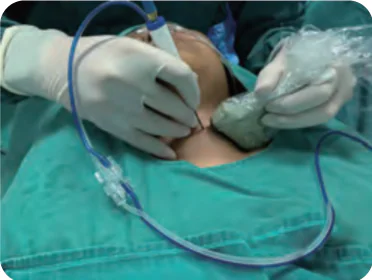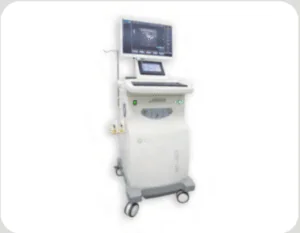
Microwave Ablation
_____________________________

Schedule Consultation

Schedule Consultation
Microwave Ablation (MWA)
Microwave Ablation (MWA) represents the latest advancement in tumor ablation technology. It is a thermal ablation technique that destroys cancerous tissue using heat generated by electromagnetic microwaves. This method has shown excellent results in the treatment of solid tumors across various organs.


Development of Ablation Techniques
The development of ablation therapies has progressed rapidly, with Microwave Ablation (MWA) emerging as the most advanced approach to treating tumors through heat. Unlike traditional methods such as radiofrequency ablation, MWA achieves higher and more uniform temperatures, resulting in faster and more complete tumor destruction.
Depending on the tumor’s size and location, the procedure can be performed through percutaneous, laparoscopic, or open surgical access. Under imaging guidance (CT or ultrasound), a thin 14.5-gauge microwave antenna is inserted directly into the tumor. This antenna is connected to a generator that emits electromagnetic waves through its active tip, producing rapid heating within the targeted tissue.
The microwaves cause water molecules within the surrounding tissues to oscillate rapidly. This molecular motion generates frictional heat, which raises the local temperature and causes cell death through coagulation necrosis.
Clinical Applications
Microwave Ablation is effective for treating both primary and metastatic tumors in the following organs:
- Liver (primary and metastatic liver tumors)
- Lungs (non-small cell and metastatic lesions)
- Kidneys and adrenal glands
- Pancreas and bone metastases
- Soft tissue and pelvic tumors
Current Challenges and Future Prospects
Although current thermal ablation techniques like MWA show strong clinical potential, the underlying technology remains in development. Continuous improvements in energy delivery systems and real-time temperature monitoring are enhancing precision and safety.
Increasing intratumoral temperatures have been found to reduce ablation volume while improving speed and modifying the convection profile within the ablation zone. As these technologies mature, MWA is expected to become one of the most reliable and efficient local treatments for solid tumors.
Overall, Microwave Ablation combines precision, speed, and minimal invasiveness — offering patients a safe and effective alternative to traditional surgery, especially for tumors that are difficult to remove surgically.
Our Specialties & Procedures
Explore our range of advanced cancer care procedures designed to provide comprehensive treatment and improve your well-being.
Advanced Therapies For Cancer
Innovative and precise cancer treatments combining advanced technology, targeted therapy, and personalized medicine for better recovery outcomes.
Explore More →Treating Specific Cancer
Specialized treatment plans for different cancer types — including liver, lung, breast, and bone cancers — with a focus on patient comfort and long-term wellness.
Explore More →Our Specialties & Procedures
Explore our range of advanced cancer care procedures designed to provide comprehensive treatment and improve your well-being.
Advanced Therapies For Cancer
Innovative and precise cancer treatments combining advanced technology, targeted therapy, and personalized medicine for better recovery outcomes.
Explore More →Treating Specific Cancer
Specialized treatment plans for different cancer types — including liver, lung, breast, and bone cancers — with a focus on patient comfort and long-term wellness.
Explore More →ABOUT FUDA CANCER HOSPITAL
OUR ACHIEVEMENTS
Achievements of FUDA CANCER HOSPITAL
50+ Doctors
Professional Experts
1200+ Patients
Happy Indian Patients
100+ Countries
Global Presence
500+ Employees
Dedicated Workforce
Advanced Therapies for Cancer of All Stages
Nano Knife IRE (Irreversible Electroporation)
Cryotherapy | Cryosurgery | Cryo-ablation
Brachytherapy for Cancer
Microvascular Interventional Chemotherapy
Patient Testimonials
Mrs. Pratibha Rajgopal
Mrs. Dipikabehan Parmar
Mrs. Roseline Chandran
Mrs. Jyoti Bhatia
